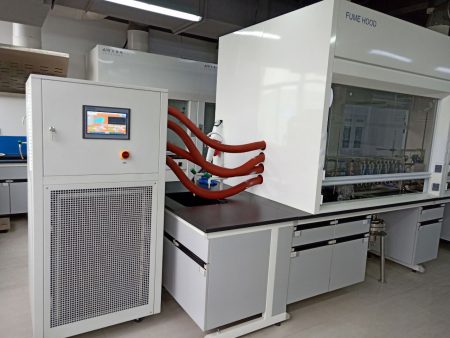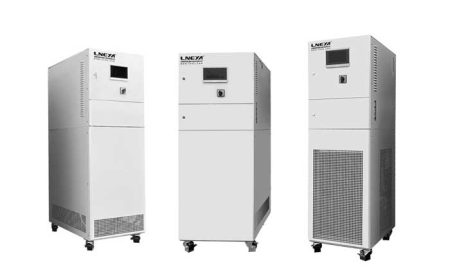Water Glycol Cooling System
Contattateci oggi stesso per la soluzione di controllo della temperatura perfetta
A water glycol cooling system is an industrial refrigeration system that uses an antifreeze called ethylene glycol mixed with water to lower the freezing point of the refrigeration system in the application.
Ethylene glycol is a class of organic compounds belonging to the alcohol family. When mixed with water and pumped through the pipes of a cooling system, ethylene glycol slows down freezing. It helps maintain temperature consistency across applications. Some glycol products can also inhibit corrosion and bacterial growth within cooling system piping.
Comparison of Two Ethylene Glycols
There are two varieties of ethylene glycol that should never be mixed together: ethylene glycol and propylene glycol. Both types offer the same relative frost protection rating. Both also help prevent corrosion. Certain grades of both types of glycol can also help prevent the growth of algae and bacteria inside the cooler.
Ethylene glycol
Ethylene glycol is a moderately toxic chemical that has a sweet taste and may be harmful if swallowed. Therefore, it should not be used in drinking water or food processing systems where leakage is possible. Ethylene glycol is more widely used due to its lower purchase price. Industrial applications such as skating rinks and factories that require large amounts of coolant find this to be the most economical option for ethylene glycol.
Propylene glycol
Propylene glycol is less toxic and is considered a food-grade antifreeze. This type of glycol is safer than ethylene and easier to handle. Propylene glycol is commonly used in the food industry or in industrial refrigeration systems where people may come into contact with liquids. Propylene glycol may also be more viscous than ethylene, slightly affecting heat exchange rates even when used at very low temperatures. It is important to note that you should never mix different types or brands of glycols as this can cause condensation of the product and clogging of filters in the refrigeration system, which can cause heat transfer and fluid flow problems.

Mixing water with ethylene glycol in industrial refrigeration systems
Ethylene glycol must be mixed with water to function properly. The type and amount of water to be used are key factors to consider.
Water type
Each glycol chiller has its own set of manufacturer recommendations for the best type of water to use with the system. Although tap water is initially acceptable, long-term use of deionized water is rarely recommended as it may adversely affect certain metals in the cooler. Sometimes manufacturers require coolers to use distilled or reverse osmosis water. The key is to check with the manufacturer about your refrigeration system’s specific needs.
The ratio of water to ethylene glycol
Calculating the appropriate ratio of glycol to water in a cooling system depends on the coldest temperature the glycol solution will reach during operation. If the cooling system is used indoors where there is no chance of freezing, the amount of glycol required will be significantly less than that required for a glycol chiller where outdoor temperatures tend to drop below freezing. Additionally, if the application requires very low temperatures to operate, a glycol mixture similar to that used in outdoor systems should be used. In cooling systems, this temperature is typically the saturated suction temperature in the evaporator, and this temperature is typically 10°F below the cooler set point temperature. It is important to use the proper ratio of glycol and water in your cooling system.
Forniamo progettazione e produzione di sistemi di controllo della temperatura completi. Da modelli standard a prodotti completi e personalizzati fino a 900 tonnellate. Siamo specializzati nell'assistenza ai clienti e ci dedichiamo ad aiutare ogni cliente ad avere il sistema di controllo della temperatura ottimale per le sue esigenze specifiche.
Forniamo soluzioni personalizzate non standard. Sono disponibili sia chiller a raffreddamento singolo che unità combinate di raffreddamento e riscaldamento.
E-mail: info@lneya.com ID WeChat: +8615251628237 WhatsApp: +86 17851209193
Refrigeratori di raffreddamento

Refrigeratori a ricircolo / Circolatore refrigerato
Il refrigeratore può essere ampiamente utilizzato in vari settori industriali e laboratori e supporta la progettazione personalizzata.
| Intervallo di temperatura | Serie -25°C ~ +30°C | Serie -45°C ~ +30°C | Serie -60°C ~ -20°C | Serie -80°C ~ -20°C | Serie -120°C ~ -70°C | ||||
| Capacità di raffreddamento | 0,8 ~ 30kW | 0,75 ~ 12kW | 0,4 ~ 6kW | 0,2 ~ 6kW | 0,3 ~ 5kW | ||||
| Nota: qualsiasi intervallo di temperatura da -150℃ a +350℃ e qualsiasi capacità di raffreddamento possono essere personalizzati. | |||||||||
 Refrigeratori d'acqua / Piccoli refrigeratori
Refrigeratori d'acqua / Piccoli refrigeratori
Il refrigeratore può essere ampiamente utilizzato in vari settori industriali e laboratori e supporta la progettazione personalizzata.
| Intervallo di temperatura | -18°C ~ +30°C | Serie +5°C ~ +35°C | |||||||
| Capacità di raffreddamento | 0,35 ~ 0,9 kW | 1,8 ~ 50kW | |||||||
| Nota: qualsiasi intervallo di temperatura da -150℃ a +350℃ e qualsiasi capacità di raffreddamento possono essere personalizzati. | |||||||||

Refrigeratori a bassa temperatura
Siamo specializzati nella produzione di refrigeratori a bassa temperatura con un range di controllo della temperatura fino a -150°C, in grado di soddisfare le esigenze di refrigerazione di diversi settori industriali.
| Intervallo di temperatura | Serie -25°C ~ -5°C | Serie -45°C ~ -10°C | Serie -60°C ~ -10°C | Serie -80°C ~ -30°C | Serie -110°C ~ -50°C | Serie -150°C ~ -110°C | |||
| Capacità di raffreddamento | 12 ~ 360kW | 6 ~ 180kW | 6 ~ 180kW | 4 ~ 180kW | 2 ~ 120kW | 2,5 ~ 11kW | |||
| Nota: qualsiasi intervallo di temperatura da -150℃ a +350℃ e qualsiasi capacità di raffreddamento possono essere personalizzati. | |||||||||

Refrigeratori ad alta temperatura
Il refrigeratore può essere ampiamente utilizzato in vari settori industriali e laboratori e supporta la progettazione personalizzata.
| Intervallo di temperatura | +5°C ~ +40°C | -25°C ~ +40°C | -45°C ~ +40°C | -80°C ~ +80°C | -100°C ~ +80°C | ||||
| Capacità di raffreddamento | 6 ~ 40kW | 2 ~ 15kW | 1 ~ 8kW | 0,6 ~ 3kW | 1,5 ~ 3kW | ||||
| Nota: qualsiasi intervallo di temperatura da -150℃ a +350℃ e qualsiasi capacità di raffreddamento possono essere personalizzati. | |||||||||
Refrigeratori per il raffreddamento e il riscaldamento

Refrigeratori per il raffreddamento e il riscaldamento
Intervallo di controllo della temperatura: da -120°C a +350°C
termostato di raffreddamento e riscaldamento, ampiamente utilizzato in vari settori industriali.
| Intervallo di temperatura | Serie -10 ~ +150°C | Serie -25 ~ +200°C | Serie -25 ~ +300°C | Serie -45 ~ +250°C | Serie -45 ~ +300°C | Serie -60 ~ +250°C | Serie -60 ~ +300°C | Serie -70 ~ +250°C | Serie -80 ~ +250°C | Serie -90 ~ +250°C | Serie -100 ~ +100°C | ||
| Capacità di raffreddamento | 1,5 ~ 15kW | 1 ~ 200kW | 1 ~ 200kW | 0,45 ~ 200kW | 0,9 ~ 25kW | 0,25 ~ 60kW | 0,75 ~ 25kW | 0,4 ~ 15kW | 0,3 ~ 80kW | 0,2 ~ 80kW | 0,45 ~ 80kW | ||
| Nota: qualsiasi intervallo di temperatura da -150℃ a +350℃ e qualsiasi capacità di raffreddamento possono essere personalizzati. | |||||||||||||

Riscaldatori a ricircolo Refrigeratori
Intervallo di controllo della temperatura: da -45°C a +250°C
| Intervallo di temperatura | Serie -25°C ~ +200°C | Serie -45°C ~ +250°C | |||||||
| Capacità di raffreddamento | 1 ~ 15kW | 0,25 ~ 15kW | |||||||
| Nota: qualsiasi intervallo di temperatura da -150℃ a +350℃ e qualsiasi capacità di raffreddamento possono essere personalizzati. | |||||||||
 LNEYA
LNEYA
 简体中文
简体中文


















































































